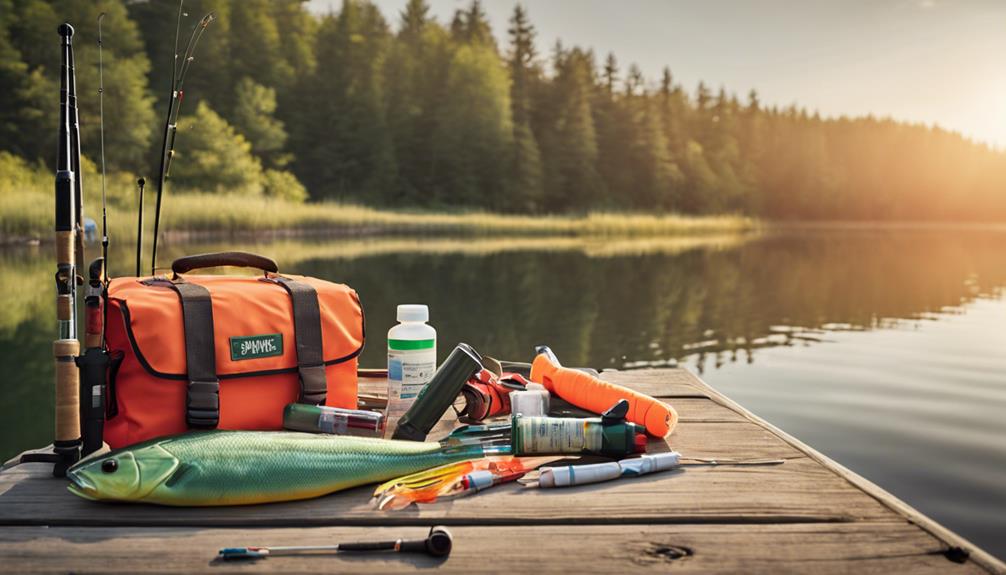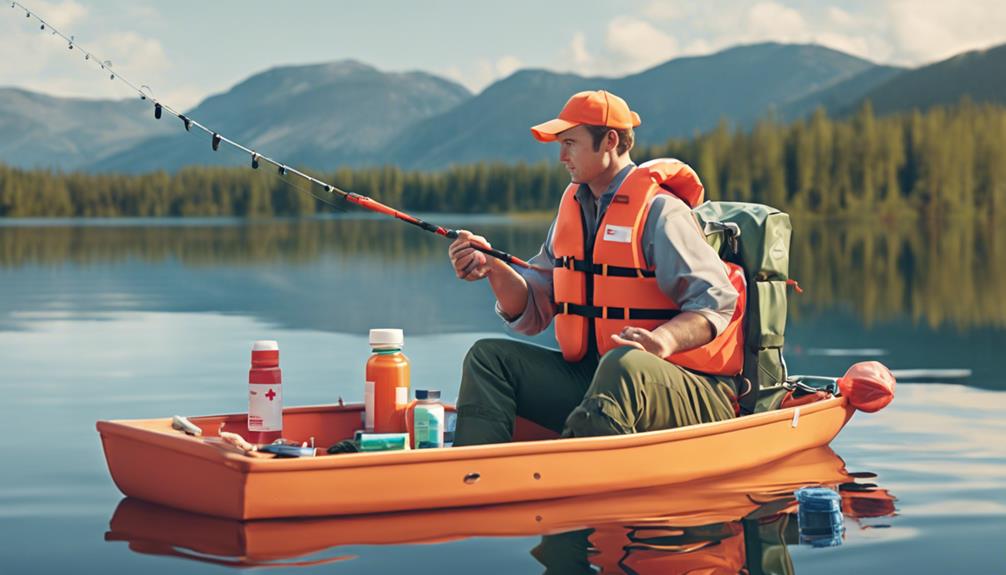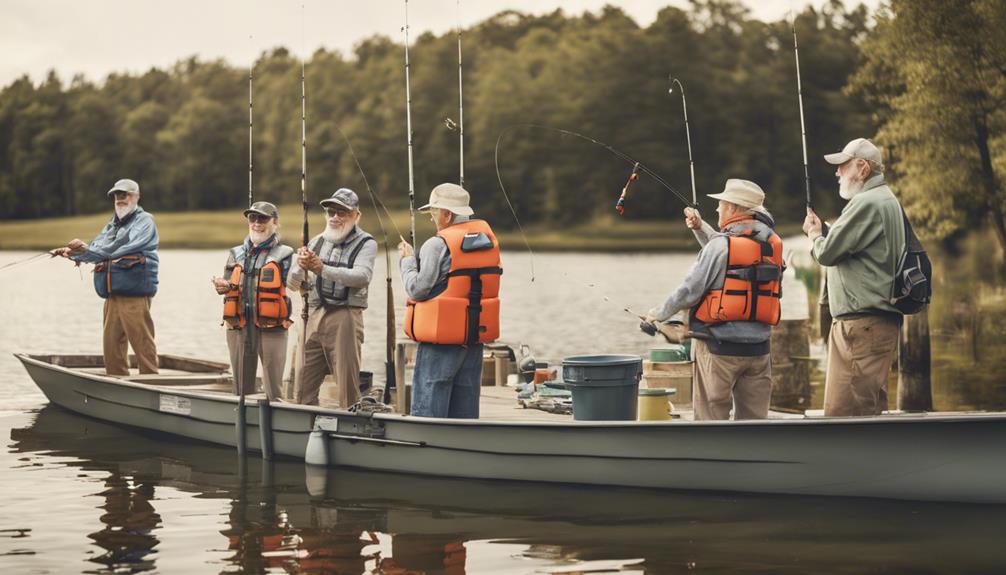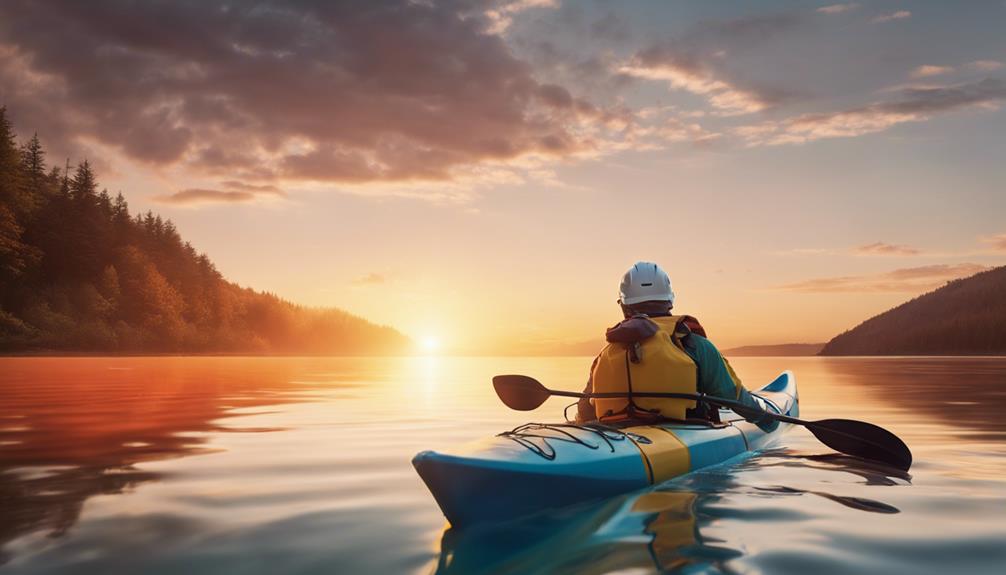When it comes to angling, you're likely well-versed in the art of patience and strategy. But have you considered the essential safety gear that could make all the difference during your fishing adventures?
From the crucial Personal Flotation Devices (PFDs) to a trusty First Aid Kit, each item plays a vital role in ensuring your well-being while out on the water. But there's one piece of gear that often goes overlooked, yet could be a lifesaver in unexpected situations.
Can you guess what it is? Find out more about this must-have safety equipment for angling enthusiasts.
Personal Flotation Devices (PFDs)
When angling on the water, ensure your safety by wearing a Personal Flotation Device (PFD) at all times. PFDs come in various types and brands, each designed to cater to different needs and preferences. It's essential to choose a PFD that fits you well and provides maximum comfort for a prolonged period on the water.
When selecting a PFD, consider the type that suits your angling activities. Inflatable PFDs are lightweight and comfortable, ideal for anglers looking for freedom of movement. On the other hand, foam PFDs are more buoyant and suitable for rough waters. Popular brands like Mustang Survival and Stohlquist offer a range of PFDs with different features to ensure your safety on the water.
Ensuring the proper fit of your PFD is crucial for your safety. A well-fitted PFD should be snug but not too tight, allowing you to move comfortably without riding up. Adjustable straps and buckles help customize the fit to your body, providing security while angling. Additionally, consider the level of comfort the PFD offers, especially if you plan to spend long hours fishing. Look for features like mesh lining, padded shoulders, and ventilation to enhance comfort during your angling adventures.
First Aid Kit
To ensure your safety while angling, a well-stocked first aid kit is essential for handling any unexpected injuries or emergencies that may occur during your fishing excursion. The importance of a first aid kit can't be overstated, as it allows you to address minor cuts, scrapes, or more serious injuries promptly. In emergency situations, having the necessary supplies readily available can make a significant difference in the outcome.
Proper training in first aid procedures is crucial for effectively utilizing the contents of your kit. Knowing how to apply basic treatments like cleaning and bandaging wounds, stabilizing sprains, or managing burns can prevent complications and promote faster recovery. Being prepared with the right skills and equipment enhances your ability to handle unforeseen medical incidents with confidence.
Prevention strategies are another aspect to consider when it comes to first aid preparedness. While accidents can happen unexpectedly, taking precautions such as wearing appropriate footwear to avoid slips, using sunscreen to prevent sunburn, or staying hydrated to prevent heat-related illnesses can reduce the likelihood of needing to use your first aid supplies. Remember, being proactive about safety measures can help you enjoy your fishing experience to the fullest while minimizing risks.
Emergency Communication Device
Carrying an emergency communication device is crucial for ensuring prompt assistance in case of unforeseen emergencies while angling. When you're out on the water, having a reliable way to communicate distress signals can make a significant difference in getting help quickly. Here are some essential emergency communication devices you should consider adding to your angling gear:
- Satellite Phone: A satellite phone is a valuable tool to have in remote areas where regular cell phone coverage may be spotty or nonexistent. It allows you to make calls and send distress signals via satellite networks, ensuring you can reach emergency services when needed.
- GPS Tracker: A GPS tracker is essential for providing your exact location in case of emergencies. It can help rescuers pinpoint where you are, especially if you're unable to communicate your location accurately. This device can be a lifesaver when every minute counts.
- Personal Locator Beacon (PLB): A PLB is a compact device that, when activated, sends out a distress signal with your location to emergency responders via satellite. It's a reliable tool for summoning help when you're facing a life-threatening situation on the water.
- Two-Way Radio: A two-way radio is useful for staying in communication with your fishing buddies or nearby boats. In emergencies, it can be used to call for help and coordinate rescue efforts effectively.
Safety Whistle
Having a safety whistle on hand is essential for alerting others in case of emergencies while angling, providing a loud and easily recognizable signal for assistance. When it comes to whistle maintenance, ensure your safety whistle is clean and free of debris that could obstruct its sound range. Regularly check for any damages and replace the whistle if needed to guarantee it functions properly when you need it most.
In emergencies, knowing effective signaling techniques can be crucial. To signal for help using a whistle, use three short blasts in quick succession, a universal distress signal. This pattern is recognized by many as a call for assistance. Additionally, you can use long blasts to grab attention or if you see someone in distress. It's important to familiarize yourself with these emergency signaling methods beforehand to act swiftly during critical situations.
While a safety whistle is a popular choice for signaling, there are whistle alternatives you can consider. Some anglers opt for signal mirrors, air horns, or even personal locator beacons for added safety measures. Each alternative has its advantages, so choose the one that best fits your angling needs and environment. Remember, the goal is to have a reliable means of calling for help when angling solo or in remote areas.
Sun Protection Gear
Ensure you have adequate sun protection gear while angling to shield yourself from harmful UV rays and prevent sunburn. When spending long hours under the sun, it's crucial to protect your skin and eyes.
Here are some essential items to consider:
- Wide-brimmed Hat: A wide-brimmed hat provides excellent UV protection for your face, neck, and ears. Look for hats with UPF (Ultraviolet Protection Factor) rating for maximum sun protection.
- Sunglasses with UV Protection: Invest in polarized sunglasses that offer 100% UV protection. This won't only shield your eyes from harmful rays but also reduce glare off the water, allowing for better visibility while fishing.
- Cooling Towel: A cooling towel with advanced cooling technology can help you stay comfortable in the heat. Simply wet the towel, wring out the excess water, and place it around your neck to enjoy the cooling effect.
- Sunscreen: Don't forget to apply a broad-spectrum sunscreen with a high SPF rating to all exposed skin, including your face, arms, and legs. Reapply regularly, especially after being in the water or sweating.
Protective Footwear
Consider the importance of wearing protective footwear while angling to safeguard your feet from potential hazards and ensure a comfortable fishing experience. When choosing footwear for fishing trips, opt for shoes or boots with traction control to prevent slipping on wet surfaces like boat decks or riverbanks. A non-slip sole is crucial to maintain stability, especially in unpredictable weather conditions.
Additionally, prioritize footwear with a waterproof design to keep your feet dry and comfortable throughout your angling adventures. Waterproof footwear helps protect against water seepage, ensuring that your feet stay warm and blister-free even when wading in shallow waters or during rainy days. Wet feet can lead to discomfort and even injury, so investing in waterproof footwear is a wise decision for any angling enthusiast.
Whether you prefer sturdy boots or lightweight shoes, make sure they provide adequate support and protection for your feet. Look for options with reinforced toe caps and ankle support to shield against accidental impacts or uneven terrain. By prioritizing traction control and waterproof features in your angling footwear, you can focus on enjoying your fishing experience without worrying about foot-related discomfort or hazards.
Knife or Multi-tool
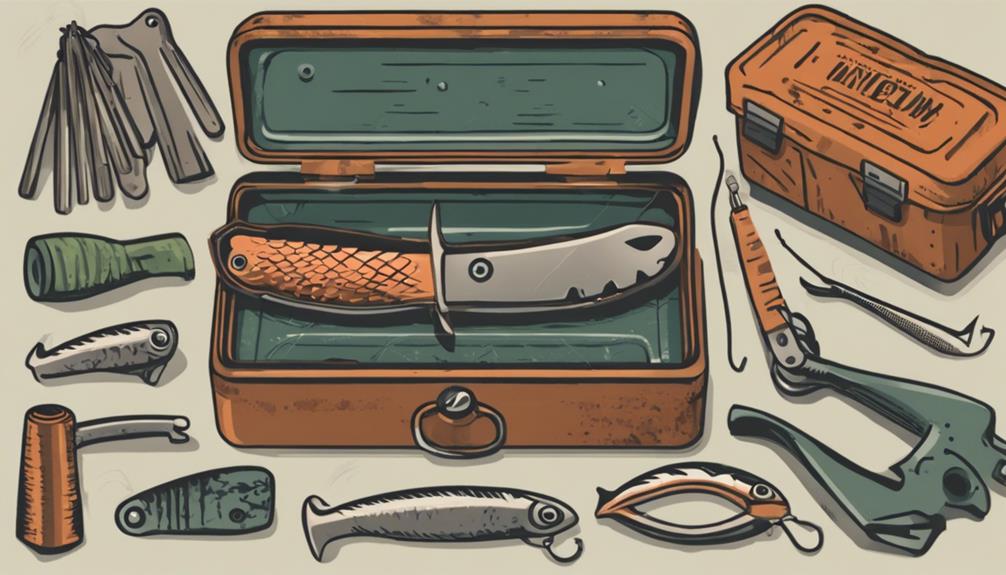
When angling, having a reliable knife or multi-tool at hand is essential for various tasks such as cutting lines or preparing bait efficiently. Whether you're a beginner or seasoned angler, knowing how to use and handle these tools properly is crucial for your safety and the success of your fishing trip.
Here are some key points to consider when it comes to knives and multi-tools:
- Knife safety: Always make sure your knife is sharp to avoid accidents caused by applying too much force. Keep it securely stored when not in use and handle it with care to prevent injuries.
- Multi-tool versatility: A multi-tool can serve multiple purposes beyond cutting, such as removing hooks, tightening screws, or opening bottles. Its versatility makes it a valuable asset in your fishing gear collection.
- Maintenance: Regularly clean and oil your knife or multi-tool to prevent rust and ensure smooth operation. Check for any loose parts or signs of wear that may affect performance.
- Legal considerations: Be aware of local laws and regulations regarding carrying knives or multi-tools while fishing. Some areas may have restrictions on blade length or the type of tools allowed.
Weather-Appropriate Clothing
Having the right weather-appropriate clothing is crucial for staying comfortable and safe during your angling adventures, complementing the functionality of your essential tools like a knife or multi-tool. When preparing for a day of fishing, consider layering essentials to adapt to changing weather conditions. Start with a moisture-wicking base layer to keep sweat away from your skin, add a thermal mid-layer for insulation in cold weather, and top it off with a waterproof outer shell to stay dry in case of rain or splashes.
In cold weather, thermal apparel becomes your best friend. Look for thermal shirts and pants made from materials like merino wool or synthetic fabrics that retain heat even when wet. Insulated jackets and pants can provide extra warmth without adding bulk, allowing you to move freely as you reel in your catch. Remember to protect your extremities with thermal socks, gloves, and hats to prevent frostbite.
Investing in waterproof gear is also essential for anglers. A good quality rain jacket and pants will keep you dry during unexpected showers, while waterproof boots or waders are vital for staying comfortable when fishing in streams or rivers. By dressing appropriately for the weather, you can focus on enjoying your angling experience without worrying about discomfort or safety hazards.
Frequently Asked Questions
What Type of Certifications or Approvals Should I Look for When Purchasing a Personal Flotation Device (Pfd)?
When choosing a personal flotation device (PFD), make sure to look for certifications and safety standards. These indicate that the PFD meets specific safety requirements.
Additionally, pay attention to proper fit and sizing for PFDs. A well-fitted PFD will ensure it functions correctly in case of an emergency.
Are There Any Specific First Aid Items That Are Essential for Treating Common Fishing-Related Injuries?
When it comes to fishing safety and emergency preparedness, having first aid essentials is crucial. Common injury treatments like antiseptic wipes, adhesive bandages, and gauze pads should be in your kit.
Additionally, items such as tweezers for removing hooks, pain relievers, and insect bite relief can come in handy. Being prepared with these supplies can help you address fishing-related injuries quickly and effectively.
How Far Can an Emergency Communication Device Typically Transmit a Distress Signal in Open Water?
In open water, emergency communication devices like personal locator beacons or satellite messengers can typically transmit a distress signal over a considerable distance. These devices have varying signal strengths, but they're designed to cover a wide range to ensure that your distress signal reaches authorities for help.
The range of these emergency beacons can vary depending on the specific device and the surrounding conditions, so it's essential to check the specifications for accurate information.
What Decibel Level Should a Safety Whistle Reach in Order to Be Effective in Alerting Others to Your Location?
To be effective in alerting others to your location, a safety whistle should reach a decibel level that stands out in emergency situations. Effective communication and emergency response depend on the whistle's sound carrying far and cutting through other noises.
A whistle reaching around 100 decibels is recommended for ensuring that you can be heard and located quickly, especially in open water or wilderness settings where visibility may be limited.
Is There a Specific Type of Material or Design That Is Best for Protective Footwear When Angling in Rocky or Slippery Terrain?
When angling in rocky or slippery terrain, the best materials for protective footwear are durable and water-resistant. Look for slip-resistant designs that provide traction on various surfaces.
Materials like rubber or synthetic compounds offer flexibility and grip. Opt for shoes with reinforced toe caps for added protection.
Conclusion
Make sure you have all the essential safety gear before heading out for your next fishing trip. Personal flotation devices, a first aid kit, and emergency communication devices are crucial for your safety on the water. Don't forget sun protection gear, a safety whistle, and protective footwear.
And always be prepared with a knife or multi-tool, weather-appropriate clothing, and any other gear you may need to stay safe while enjoying your angling adventures.
